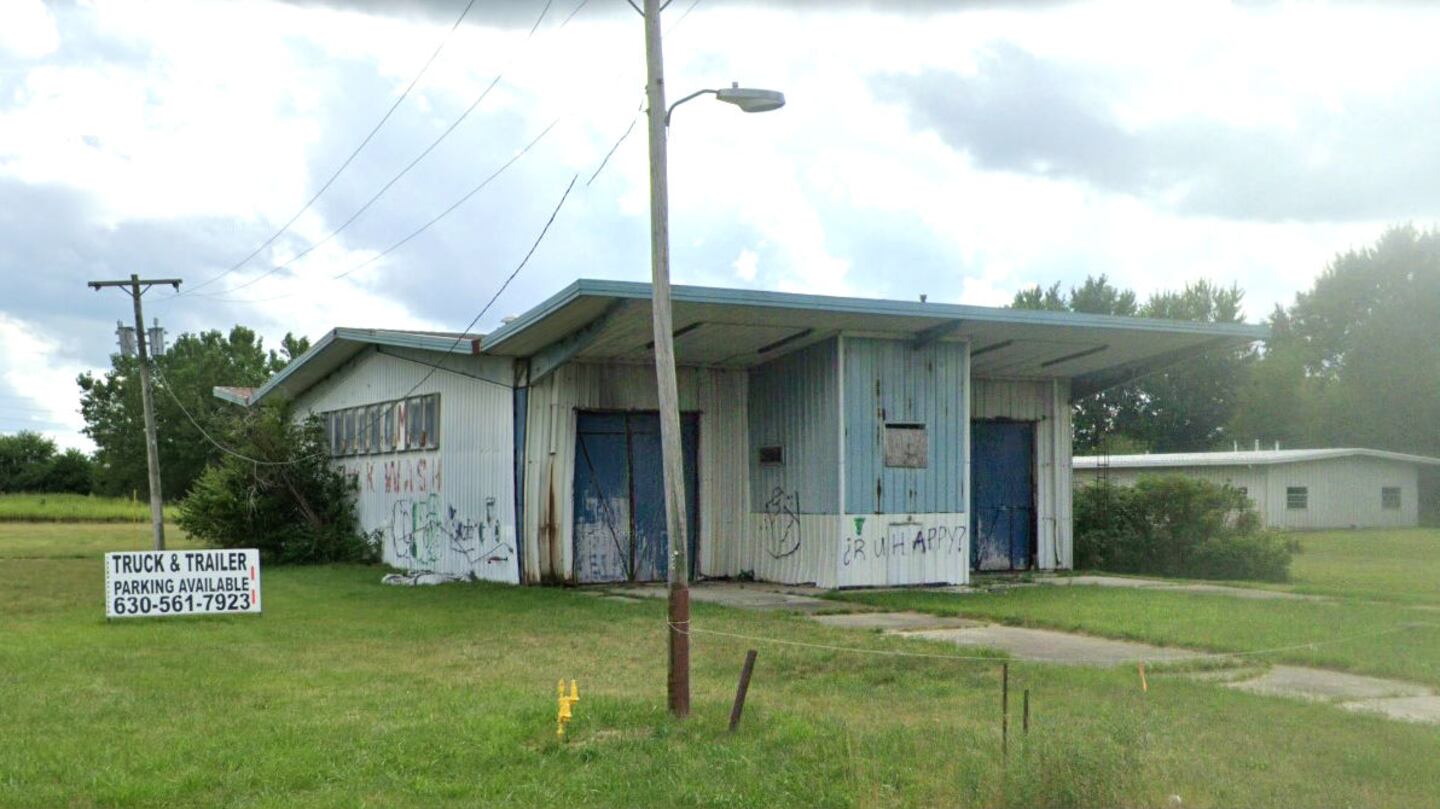LASALLE, Ill. — “They try to fight, but it is futile. It does no good.”
The women’s eyes appear to be the size of golf balls as they are being strangled, convicted serial killer Dellmus “Heavy” Colvin said.
“The light is slowly going out. Watch the eyes. They’re like a dimmer switch of a light, where you turn it real slow, slow, slow, you’re slowly choking, slow, slow, then all of a sudden, the light just goes out.”
Colvin’s chilling words are part of a podcast confession in which the killer, who is already serving multiple life sentences in an Ohio prison, confessed to yet another killing. The podcast was conducted via phone calls from Lebanon Correctional Institution, where Colvin is housed.
Details of the murder led LaSalle County sheriff’s deputies to an abandoned Illinois truck wash where bones were found, according to walls102.com in Peru. The bones are being analyzed by the Illinois State Police.
LaSalle County Sheriff Tom Templeton told reporters that the police dogs were beginning to struggle in the heat Wednesday. The search is set to resume next week, when temperatures are expected to be cooler.
Editor’s note: The following story contains graphic details of multiple murders and may be disturbing for some readers.
Watch drone footage of the alleged crime scene below, courtesy of The Times in Ottawa, Illinois.
‘Where the Bodies are Buried’
Colvin, a 61-year-old former long-haul trucker, has been imprisoned since 2006 in connection with the murders of seven women. He has taken credit for killing dozens of unidentified women across the U.S. between 1987 and 2005.
Phil Chalmers, a criminal profiler in Florida, last month released a 43-minute podcast, compiled from several telephone interviews he did with Colvin, for his series, “Where the Bodies are Buried.” A description of Colvin’s podcast describes him as a “lady-killing long-haul trucker, drug dealer and truck stop pimp.”
“Most of Colvin’s victims were drug-addicted prostitutes that he first strangled in the cab of his big-rig truck, then transported and dumped their bodies in rural wooded areas between destinations,” the description reads.
In his own words, Colvin gave an unflinching, remorseless account of how he would kill his victims, sometimes in broad daylight, and then drive his route with their naked corpses in the cab of his truck until he found an opportune time and place to dump their bodies. He would often kill in one state, dump the victim’s body in another and get rid of their clothing in a third.
Colvin said after strangling the women, he would wrap their heads with a plastic bag and seal it with duct tape because “the last thing you want is someone popping up while you’re going down the interstate about 70 or 80 mph.”
“It could be all bad, because when they wake up they would be delirious,” he said.
The killer joked that the dead women were good passengers because they didn’t complain about his music or ask for anything.
“You ain’t got to share your goodies with them,” Colvin said. “‘You want some Wendy’s, baby?’ Hell no. She don’t need nothing.”
It was more than 30 minutes into the podcast before the multiple murderer delved into the victims who have never been found. He refused to talk about any cases in death penalty states.
“Texas, Michigan, I have a list of all the states that has that,” Colvin said.
When asked which of his still-missing victims would be the easiest to locate, Colvin didn’t hesitate: LaSalle, Illinois.
‘You want some Wendy’s, baby?’ Hell no. She don’t need nothing.”
— - Dellmus Colvin, speaking about his slain victims
Colvin said he was doing paperwork in the cab of his truck outside a Flying J in LaSalle when the woman knocked on the door.
“I said, ‘Beat it. Get the (expletive) out of here,’” he said. The woman left, but returned a few minutes later.
Colvin said he went into the store, bought a few log books, returned to his truck and strangled the woman in the sleeper bunk of his rig.
He then drove away from the store, heading west. It had begun to rain, he said.
Colvin said he recalled an abandoned truck wash and headed there.
“It was deserted. No one comes down there. It’s dark and it’s scary,” Colvin said with a laugh. “I pulled all the way in the back. The weeds are so high, and I just remember picking (the body) up on my shoulder and into the woods I go.”
He dumped the body and “got the hell up out of there,” Colvin said. He bagged up the woman’s clothes and dumped them in Council Bluffs, Iowa.
Colvin recalled the unidentified woman as wearing dirty sweatpants, dingy shoes and a dingy T-shirt with a cartoon character like Garfield or Tweety Bird on it. She was white, with “dishwater blonde” hair.
Her hair was combed over her right eye because the eye was blackened, Colvin said.
“Someone dotted that eye,” Colvin said with a laugh. “It wasn’t me.”
Colvin told Chalmers he took the woman’s body into an area across from the truck wash, about 30 feet from the road, and dropped her there.
On Wednesday, law enforcement officials with cadaver dogs descended on the area around the abandoned building. They found bones, though it was not immediately clear if the bones were human or animal.
Many authorities are on the scene at the old truck wash near the Tiki on La Salle Road (May Road) on the border of La Salle and Peru. Authorities believe human remains have been found. pic.twitter.com/IQZwg7vNRl
— Scott Anderson (@NT_Photo2) September 2, 2020
‘I was a square’
Colvin’s demeanor as he spoke to Chalmers was cheerful. He explained that he is serving consecutive life sentences for the murders of two of the women he killed, Jackie Simpson, 33, and 37-year-old Melissa Weber. Both were killed in Toledo in 2003.
“It was a capital case. I was on my way to death row, so I made a deal with them at the last minute ’cause the trial, it wasn’t going right,” Colvin said. “I seen the writing on the wall and I told them I could give them some cold cases. So, I gave them two (more).”
According to The Toledo Blade, DNA was taken from Colvin in 2004 in connection with the sexual assault of a woman who fled and called police. The following year, that DNA sample linked him to Weber’s murder, as well as Simpson’s slaying and a 1998 sexual assault.
Colvin’s DNA was found under Weber’s fingernails, the Blade reported.
Colvin, then 47, pleaded guilty in 2006 to his role in a total of five murders at that point. All the women were working as prostitutes when they were killed.
Some of Colvin’s victims were his own workers, he told Chalmers.
Simpson was smothered with a pillow at a South Toledo motel. Her decomposed remains were found April 23, 2003, under some bushes.
Listen to Colvin’s “Where the Bodies are Buried” podcast below. Warning: The audio contains explicit language and graphic descriptions of multiple murders.
Colvin said he killed Simpson because she was annoying him.
“All the time she was there, she was crying about her mama, her creepy uncle and (expletive),” Colvin said in the podcast. “I don’t care nothing about that. I just got tired of her (expletive) whining.”
Colvin said he kept Simpson’s body in his truck for months, even driving to a court date on a burglary charge with her decomposing remains in tow.
Weber’s body was found May 9, 2005, under a couch in a vacant trucking terminal, the Blade reported.
The other three women Colvin pleaded guilty to killing were:
- Valerie Jones, 38, whose skeletal remains were found Jan. 6, 2000, near a landfill;
- Jacquelynn Thomas, 42, whose body was found Sept. 2, 2000, alongside a road; and
- Lily Summers, 43, whose body was found April 8, 2002, in a tractor-trailer behind a business.
In October 2006, Colvin admitted his involvement in a sixth killing, that of Dorothea Wetzel, 40, in Toledo. Wetzel’s body was found Aug. 5, 2000, on the bank of the Maumee River.
He would be linked in 2010 to the cold case killing in Atlantic City of Donna Lee White, 27, of Somers Point.
In the podcast, Chalmers asked Colvin if he had any of the so-called telltale signs of a budding serial killer as a child, like wetting his bed, setting fires or harming animals. Colvin burst out in a hearty laugh and told Chalmers he’d “been watching too much ‘Criminal Minds.’”
“I didn’t do none of that. That’s why I flew under the radar for so long,” Colvin said.
He said that he hunted animals when he was young but, “if (he) killed a rabbit, (he) ate that (expletive).”
He went on to describe a normal upbringing growing up on a farm in Akron, with no abuse or neglect that could explain his later propensity for violence. In school, he wrestled and played football.
“I was a square. Hell, I’d never even been suspended from school,” Colvin said. “But all the profiling, man, I didn’t fit the bill to none of that.”
That’s the first person I actually thought about killing. I had no way of dumping her fat (expletive) body. I couldn’t get that on the trailer and get it to the woods.”
— - Colvin talking about his stepmother
Not all was well in the Colvin household, however. The admitted killer told Chalmers about his hatred of his stepmother, whose murder he fantasized about at age 14.
“That’s the first person I actually thought about killing,” Colvin said. “I had no way of dumping her fat (expletive) body. I couldn’t get that on the trailer and get it to the woods.”
He laughed as he talked about plotting to shoot the woman but said he lacked one thing: a gun.
“I had a bow and arrow,” he said with a laugh. “A compound bow. It was huge back then.”
Colvin said one day, as he was showing his brother how to shoot the bow, his brother fired an errant shot that sent an arrow through a window and into a cabinet where their stepmother was busy cooking.
“She swore up and down I was trying to kill her, and I let her believe that, too,” Colvin said. “Ever since then, she was scared to death of me.”
‘The Interstate Killer’ emerges
Colvin said he began killing around the age of 24.
“I never counted,” Colvin said of his victim count. “I averaged one to two a year. My best year, I did three. Calculate that, it comes to between 47 to 52.”
Colvin said he also once “finished off” a victim with one hand while using his free hand to talk to his mother on his cellphone. His mother had called because he was late for where he was supposed to be, the killer said.
“I had already started. I was just putting the final touches on it,” he said.
Colvin said his first killing took place in New Jersey, where he picked up a hitchhiker.
The woman wanted him to make a detour, which he refused to do. When she “gave him lip,” he strangled her.
“She ended up in Pomona, in the woods,” Colvin said.
He said the hardest part of committing murder was the physicality of strangulation. Dumping a body was easy.
“Oh my God, everything from Hamilton, New Jersey, it ain’t nothing but woods,” Colvin said. “It’s a dumping paradise.”
Colvin laughed as he talked about strangling his first victim, into whose eyes he looked as he killed her. An avid reader, he said he’d always read that looking into a person’s eyes as you killed them would “haunt you forever.”
“That’s a damn myth. I know that for a fact,” Colvin said with a chuckle. “I slept great that night.”
The killer went on to discuss how he chose strangulation or suffocation for his victims because it is “personal,” and that if the body is found at the right time, it is hard to determine the cause of death.
NBC 24 in Toledo reported in 2010 that Donna Lee White’s death was initially attributed to a drug overdose. White was found dead in a vacant lot in Atlantic City on Sept. 15, 1987.
Colvin was a suspect in her death and when it happened but the cocaine toxicity ruling closed the case, the news station reported. The case was reopened when Atlantic City police learned of Colvin’s convictions in the Toledo area.
He murdered a mother, a sister and it’s something we’ll never forget.”
— - Marshall Smith, brother of victim Donna Lee White
Colvin eventually admitted killing White after she’d injected herself with drugs, The Press of Atlantic City reported. He was sentenced in 2011 to another 30 years in prison.
White’s brother, Marshall Smith, told the court at the sentencing hearing that his sister was a triplet and part of a large, close family.
“I believe that Mr. Colvin does not show any remorse,” Smith told the court, according to the newspaper. “Indirectly, his actions caused the death of the other two triplets. They just were that close. He murdered a mother, a sister and it’s something we’ll never forget.”
The paper reported that Colvin shook his head and rolled his eyes as Smith described his family’s pain.
Colvin spoke of White’s death in last week’s podcast. He said he found White overdosed in his room at a rooming house.
“So I put the bag over her head and laid her down on the bed, and I sat there and watched football,” he said.
Colvin said he then rolled White’s body up in a carpet and carried her out of the rooming house. The landlord unknowingly held the door open for him as he moved the body and offered to help carry it to his truck.
In the podcast, Colvin told Chalmers that being a long-haul trucker is a perfect setup for murder.
“Anybody that drives the interstates at night, what do you see at night? Trucks,” he said. “And if you actually think I was the only one doing this, you are sadly mistaken.”
Chalmers agreed.
“Every time I talk to a serial killer truck driver, they all say the same thing: ‘There are many of us out here.’”
When asked about motive, Colvin said he never had sex with the women. The killing itself was his reward.
“My (motive) was pure pleasure. They’re fighting for their lives and I’m fighting for my plea … it’s pleasure,” he said.
He likened the killings to when a driver is cut off in traffic and wishes to kill the person but doesn’t do it. He described encountering the women in his day-to-day routine and getting irritated if they “bugged” him or got in the way of his business.
Unlike the driver in traffic, he acted on his irritation, Colvin said.
“Believe me, you feel a lot better,” he said with a laugh.
Cox Media Group










